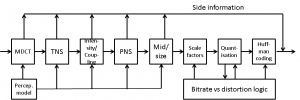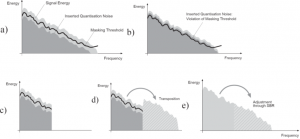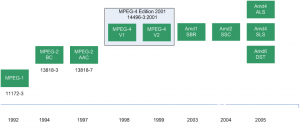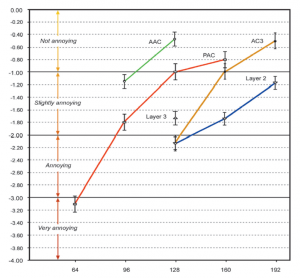| Previous chapter | Next section | Next chapter | |
| ToC | Computers And Internet | MPEG-4 Inside – File Format | Software And Communication |
MPEG-4 Audio provides complete coverage of the bitrate range of 2 to 64 kbit/s. Good coded speech is obtained already at 2 kbit/s and transparent quality of monophonic music sampled at 48 kHz and 16 bits/sample is obtained at 64 kbit/s. Three classes of algorithms are used in the standard. The first covers the low bitrate range and was designed to encode speech. The second can be used in the midrange to encode both speech and music. The third can be used in the high bitrate range and can be used for any audio signal.
MPEG-4 Audio contains a large set of coding tools through which it is possible to construct several audio and speech coding algorithms
- MPEG-4 AAC, an extension of MPEG-2 AAC.
- Twin Vector Quantisation (VQ).
- Speech coding based on Code Excited Linear Predictive (CELP) coding and on Parametric representation.
- Various usages of the Spatial Band Replication (SBR) technologies to provide high quality music at ever reduced bitrate, such as High Efficiency AAC (HE AAC).
- Various forms of audio lossless coding.
MPEG-4 AAC is MPEG-2 AAC with the addition of one tool: Perceptual Noise Substitution (PNS). This tool identifies and codes as random noise segments of spectral coefficients that appear to be noise-like. This is achieved by indicating that PNS is used and the value of the average power of the noise. A decoder uses a pseudo-random noise generator weighted by the signaled power value to reconstruct those coefficients.
Figure 1 – The MPEG-4 AAC encoder
The addition of Spectral Band Replication (SBR) MPEG-4 AAC has provided significant performance improvements. SBR consists of replicating the high band, i.e. the high frequency part of the spectrum. A small amount of data representing a parametric description of the high band is encoded and used in the decoding process. The data rate is by far below the data rate required when using conventional AAC coding of the high band.
Figure 2 – The SBR operating principle
A timeline of the development of the MPEG Audio standards is given in the figure below
Figure 3 – MPEG Audio development timeline
The MPEG-4 AA performance has been tested against a number of alternatives at different bitrates. the results are given in Figure 4.
Figure 4 – MPEG-4 AAC Verification Tests
| Previous chapter | Next section | Next chapter | |
| ToC | Computers And Internet | MPEG-4 Inside – File Format | Software And Communication |



